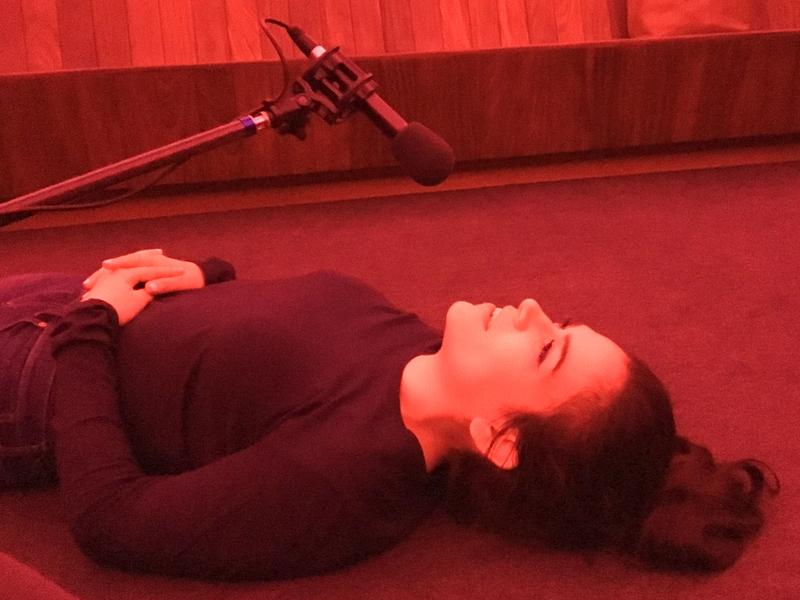Samantha Irby Gets High on Light

( Sara Bodinson )
EPISODE 4: SAMANTHA IRBY GETS HIGH ON LIGHT
Hey, it's Abbi. I wanna show you something. But I know, I know, this is a podcast so I can't actually show you. So instead, I want you to imagine something. In your head.
[MUSIC: single tone -- starts soft and slowly, slowly fades up]
So close your eyes. If you’re driving do not close you’re eyes. Maybe save this one for later. and I want you to imagine a single color. Like pink. Imagine that a light, beautiful pink is all that you can see. There are no people there, no objects, just the color pink, filling everything.
[MUSIC: tone +1]
Now over on the far left— are your eyes still closed? OK, if you’re driving again, please do not. Over on the far left I want you to imagine the color yellow. A bright, totally yellow, yellow. It's starting to fill up the left side and it's pushing against the pink. There's a brilliant, beautiful, light orange where the two colors come together.
[MUSIC: tone +2]
Now you have yellow and orange and pink and just there, over on the right, purple. A deep, rich purple and it's starting to push it's own way in. The colors are blending and mixing and making all kinds of different shades. The way single notes combine and mix and make chords and music and songs and symphonies.
[TONES FADE OUT]
[THEME MUSIC STARTS]
Lots of artists play with colors and perception and light in just this way. And today, I’m gonna take you to two of the best places to experience it.
I’m Abbi Jacobson and this is A Piece of Work.
In this episode, we’re going to be talking about artists who didn’t just use light in their work. Their work is made of light. And to fully appreciate it, you have to go and experience it.
[THEME MUSIC POST AND OUT]
Abbi: OK… Sam Irby.
Samantha Irby: Abbi Jacobson.
Abbi: Welcome to my podcast.
Samantha Irby: Thank you for having me!
Abbi: Are you ready for what is about to go down?
Samantha Irby: I think so.
I took my friend the writer Samantha Irby to see this mind-exploding work of art. She had no idea what she was in for.
Abbi: Do you have any idea what we’re looking at?
Samantha Irby: No, I didn’t Google.
Abbi: Oh my god so we’re walking into the room.
Samantha Irby: Oh my god.
Abbi: Look! Look!
Samantha Irby: Oh my god.
Abbi: This looks nuts.
Samantha Irby: This is amazing.
Abbi: Isn’t it amazing?
Sam and I are up in Long Island City in Queens, at a space for contemporary art called MoMA PS1. And we’re inside of this piece called “Meeting” by James Turrell. His specialty is making these immersive spaces full of colorful light.
[MUSIC: “Hotline Bling”] Drake: You used to call me on my cell phone / Late night when you need my love. / I know when that hotline bling / That can only mean one thing.
So you guys remember the video for “Hotline Bling?” It’s just Drake singing and sort-of dancing inside a blank room where the light is constantly changing color. It kind of looks like he’s floating. So I didn’t realize that Drake was influenced by Turrell. And now when I watch it back it’s so there. Artists inspiring artists... I love it.
Anyway, back to Long Island City and Sam and I experiencing this incredible light.
Abbi: So the room is like purple.
Samantha: What is this made of?
Abbi: It's it's an opening in the roof. Do you can we lay on the floor?
Samantha Irby: Yeah.
Abbi: Just because I heard that that's the thing.
“Meeting” is just a plain room with wooden angled benches lining the outside so you can lean back and look up at the ceiling. Except, when you look at the ceiling there’s a perfectly cut rectangle that’s open to the sky. There’s actually no glass or anything covering it. It’s actually very jarring at first because the fresh air seeps into the room and you’re not quite sure what’s going on.
And at sunset, the LED lights inside the room come on and slowly change color.
[FX: some tonal shift here to indicate color change]
And it makes the sky outside look like it’s changing color, too.
Samantha Irby: This is wild!
Abbi: This light in here is making the sky turquoise. And it's breezy in here.
Samantha Irby: Yeah it feels good.
Abbi: It's incredible in here. This is what I want my room to look like. [laughs]
Samantha Irby: So, what is this, what is it like made of? Or do you know?
Abbi: So there are these lights like on on the top of this wood big wood bench like area and they change according to the sunset every day like the timing of the sunset. So he designed this whole thing so the light changes and really changes the way the sky looks. It really feels like an optical illusion.
Samantha Irby: Yeah this is crazy. Like how does he know that this will have this effect? Like is he also a scientist? [laughs]
Abbi: I don't know like I think well.
Samantha Irby: This is what happens when you bring dumb people to look at art.
Abbi: I just asked this to the curator, I don't know.
Samantha Irby: I'm like what is this, science?
So, funny Sam should ask, because it turns out, Turrell kind of is a scientist. He studied perceptual psychology in college, and all of his art is kind of like a giant experiment in our perception of color.
Abbi: A couple years ago, I used to live in Astoria and I would come here for the parties and then go into the museum.
Peter: You’d come for the parties, but--
Abbi: Stay for the museum.
Peter: You’d come for the parties but stay for the art.
So I asked Peter Eleey, who’s the curator of MoMA PS1: how does this thing work?
Peter: When you go to a museum you often see on the on the label on the wall something that describes that this is an oil painting on canvas or a sculpture in marble. And in this case James often just says light. That the material of the work his light itself.
Abbi: That’s exciting.
Peter: He's figured out, I mean his craft over many years has been to tune how we experience light and space inside of our bodies in relation to all of these tools and levers that he has to elicit those kinds of responses from us.
Turrell takes the technology available to him--like color-changing LEDs -- and uses them to manipulate how we perceive what we see. And our brains respond to those tricks in surprising ways. For Sam and me, we got more and more messed up the longer we stayed in that room.
Abbi: This green right now is like making this look like a projection right.
Samantha Irby: Yeah.
Abbi: It looks like it's a projected on the ceiling.
Samantha Irby: Well, yeah if you like unfocus your eyes.
Abbi: Like it looks fake.
Samantha Irby: Yeah.
Abbi: Well this is nuts. You guys have to come and see this.
Samantha Irby: Yeah you guys need to see this. It's hard to intelligently describe what's happening.
Abbi: This is like you don't need drugs. I mean it all looks so fucking nuts. It's like big. Oh. There's a plane going through.
Samantha Irby: Guys we should get real fucked up and come do this again.
Abbi: I feel like I might freak out. [laughter] It’s blue again -- it’s back to almost --
Samantha Irby: So now the room is like crazy like egg yolk yellow and the sky is turquoise. This is really bananas.
Abbi: Welcome to New York baby, we’re showing you the sights and the sounds!
Samantha Irby: Oh my God. And do they cover up the hole every night?
Abbi: I think they must, yeah. If they didn't people would like sneak in here. You can't steal anything in here, yeah.
Samantha Irby: Yeah. what would they take.
Abbi: Selfies. That's what the criminals of today do. They sneak in places and they take selfies.
OK, I just wanna say that the day Sam and I did this it had been an extremely long day for me. And I was ready to relax and let loose. And you know what? I did.
Abbi: OK. I swear I'm not stoned but I'm about to make the stonerest just the stoneriest comment. [laughter] But like what I was saying about how when you put different colors next to each other they like completely change the one color -- just like people. But really true guys it really is true. Like a pink hot pink makes the sky color totally different. Sam, your color makes me totally different too, man.
Samantha Irby: Your color enhances my color.
Abbi: Back atcha.
Ah, what a day, what a girl, what a day. But when you think about it, what were Sam and I experiencing? Colored light in a room with a hole in the ceiling? Why were we feeling things? Peter broke it down a little bit for me.
Peter: It does this very interesting sleight of hand that a lot of great art does. It takes something out of the world so that we can focus on it. But in James's case it actually just uses the world as it is. He's not actually taking something and sticking it on the wall. He's cutting a hole in the wall so that we have access to this thing that we otherwise don't think about.
Abbi: Yeah. It's a big collaboration with him and everything else.
Peter: That's I think that's exactly right and that's how he likes to think about it. There's a lot of what James accomplishes with these kinds of works that's a kind of metaphysical magic. The longer you sit with it, which the setting of the sun encourages you to do, just like watching a sunset on a beach, you know, you want to stop what you're doing and sit there and watch the color of the sky change. James manages to bring that experience into the frame of an artwork.
[MUSIC]
So the next artist we’re gonna talk about used just totally normal, everyday lights from the hardware store to drastically change the way we feel in a space and almost create these portals to another dimension.
Visitor: It’s bright, it’s colorful, it’s a door. It’s a door between this side and another side.
Visitor: It reminds me if you walk through you’re going to like this mega rave kind of thing, that’s what I would imagine.
That’s next and this is A Piece of Work.
>>>>MIDROLL<<<<
[REJOIN MUSIC]
[door opening]
Abbi: Hi.
Flavin Judd: Hi.
Abbi: Hi, I’m Abbi, nice to meet you.
Flavin Judd: Hi, how are you?
Abbi: Good, how about you?
So another artist who’s well known for using light was Dan Flavin. And to see Dan Flavin’s work in a particularly cool setting, I went to the house of one of his buddies, the artist Donald Judd. Judd bought this building at 101 Spring Street in SoHo back when it was still just a handful of artists and a bunch of old industrial spaces, and he got Dan Flavin to install some of his original light pieces right in his house. Today 101 Spring Street is home to the Judd Foundation.
OK, so bear with me for a second: Donald Judd and Dan Flavin were good friends. So when Donald Judd had a son he decided to name him Flavin. Flavin... Judd. And he's my guide today.
Flavin Judd grew up here in this house, surrounded by all this beautiful incredible art.
Abbi: Were you nervous? Because it’s so beautiful in here and everything is so clearly placed in a specific way. Growing up, what if you spilled something? Were you ever worried about that kind of thing?
Flavin Judd: No. We had instructions: don’t run through the art, but otherwise, it was not a big deal.
Abbi: Yeah.
[MUSIC]
The building is really something. It’s on the corner of Spring and Mercer--it’s got five floors, with massive windows along the walls, so for an apartment in the city it’s got the most incredible light. Donald Judd had his studio here, and he and his family lived on the other floors.
The second floor is where they had their kitchen and dining room. And as I’m walking around, I can see that people lived here. But on the other hand, I’m totally in awe of the beauty of each unique object and where it’s placed and how everything is designed in a very specific, functional and beautiful way.
Abbi: I think this is my favorite floor.
Flavin Judd: It’s pretty great, right?
Abbi: It’s really great. The way it’s just completely open, the kitchen, and...
Flavin Judd: Each floor had to be wide open.
It’s completely wide open and that was one of Donald Judd’s rules: no internal walls breaking up the space.
There’s a giant table, super simple and elegant, surrounded by these perfect minimalist chairs. All designed by Flavin’s dad.
Abbi: This sofa is incredible.
Flavin Judd: You, too, can have one.
Abbi: I feel like it won’t go in my apartment.
Flavin Judd: Oh we can make that work.
Abbi: So, growing up, would you sit on this?
Flavin Judd: Yeah. Of course. It’s a chair.
Abbi: And you would use--I know, but do you know what I mean?
Flavin Judd: It was a house.
Abbi: I know, but I have to keep asking. I’m speaking for the people.
Flavin Judd: It’s a house. Every house should look like this, no?
Abbi: I agree, but I would be worried about putting something. I don’t know, it’s so beautiful.
Flavin Judd: You just gotta be careful.
Abbi: Yeah, you gotta be careful.
And I just kept thinking how strange it must be to have your childhood home turned into a museum, everything preserved the way it looked when you grew up there.
Flavin Judd: I mean, I think there’s a big difference. I think museums are many compromises at once. And Don was not a big fan of museums because of that. Because they almost never did what they were supposed to do which was to show the artwork in its best light. There were always not-well-meaning desires at play, politics, lots of things. You know, and when he got to do his own house Don could do whatever he wanted, and he took a lot more care in doing his house than a museum curator is going to do in a show that’s only up for three months. That’s just the way it goes.
Upstairs, in the bedroom, is the piece of art by Dan Flavin I came to see. It’s a series of tall squares—8 feet by 8 feet—and they’re made out of super basic fluorescent tubes. The horizontal sides are blue and the vertical sides are red. They run along the windows the whole length of the building. And they fill the room with this kind of eerie glow.
Abbi: Ok I have a question about the Flavin, just a very light question. I didn’t even mean to make a pun there.
Flavin Judd: Yeah, I’m sure you didn’t.
Abbi: When you guys went to bed, you’d just flip a switch?
Flavin Judd: Yeah, it’s the light.
Abbi: It just seems, that just seems so--I don’t know. That’s the coolest--
Flavin Judd: It’s very practical.
Abbi: It’s very practical. But it’s just like, it’s the light in the room.
Flavin Judd: Yeah, that’s it.
Abbi: That’s unbelievable.
Flavin Judd: Yeah.
Abbi: Yeah. And he began as a painter as well?
Flavin Judd: Both Don and Dan Flavin began as painters, and their art evolved out of their desire to do something more radical.
Abbi: The color that he uses, yeah, I feel like, well, I feel like, this piece is probably completely different at night in here.
Flavin Judd: It’s yeah, yeah, the light, the light is very different and it’s pretty amazing, yeah.
So this is the first time I’m seeing a Dan Flavin inside a home being used as a light. And it pretty much blows my mind. And it also makes me think about the way I use light in my home. I think sometimes you just settle for the light fixtures the apartment came with and we forget all the ways color and light can transform our mood and experience. Donald Judd made that aspect of art part of his everyday life.
Flavin Judd: The art world in New York in the late 60s, early 70s, was very small, it was all downtown, almost everybody knew each other, everybody was hanging out. It was an incredible group of men and women who had very radical ideas and were doing amazing work and I don’t think we’ve even started to explore all of the work that was done then and has largely been forgotten.
[FADE UP ON MUSIC]
Abbi: Sam, last thoughts.
Samantha Irby: This was the most incredible thing I've ever seen. I mean for real.
Abbi: Really incredible, right?
Samantha Irby: Yeah. It's like is like when things were changing and when it started to look opaque like I like felt that. So a lot of. This was a lot more feelings than I anticipated having. I mean but if you were in here like by yourself with like --
Abbi: If I were in here by myself, I don’t know what would happen.
Samantha Irby: With some sad music like I would really. Yeah.
Abbi: Oh yeah.
Samantha Irby: Some like real twinkly sad music. I would cry.
Abbi: Yeah
Samantha Irby: This shit is beautiful.
Abbi: It’s beautiful.
Samantha Irby: Yeah.
Abbi: Thank you for coming here with me.
Samantha Irby: Thanks for having me here.
Abbi: My pleas.
I know I’m never going to look at a sunset the same way again.
[MUSIC]
And that’s A PIece of Work, I’m Abbi Jacobson.
Thanks to Sam Irby, Flavin Judd, and Peter Eleey.
You can see pictures of the stuff we talked about today on our website apieceofworkpodcast.org. And if you like the show why not leave us a review wherever you get your podcasts.
The show is a co-production of WNYC Studios and MoMA.
Thanks for listening.
Abbi: did you cry
Samantha Irby: No, that’s cause my tear ducts are all dried up.
Abbi: That’s why I didn’t! Ha ha ha....
###






